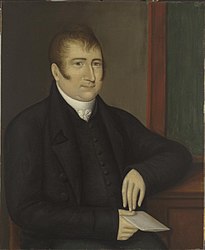File:Portrait of Edward Aisquith by Joshua Johnson.jpg

Original file (1,231 × 1,500 pixels, file size: 131 KB, MIME type: image/jpeg)
| This is a file from the Wikimedia Commons. Information from its description page there is shown below. Commons is a freely licensed media file repository. You can help. |
Summary
| Joshua Johnson: Portrait of Edward Aisquith
|
|||||||||||||||||||||||||||
|---|---|---|---|---|---|---|---|---|---|---|---|---|---|---|---|---|---|---|---|---|---|---|---|---|---|---|---|
| Artist |
artist QS:P170,Q958068 |
||||||||||||||||||||||||||
| Title |
English: Portrait of Edward Aisquith |
||||||||||||||||||||||||||
| Object type |
painting |
||||||||||||||||||||||||||
| Genre |
portrait |
||||||||||||||||||||||||||
| Description |
Joshua Johnson, the earliest documented professional African American artist, worked as a portrait painter in Baltimore from about 1795 to 1825, producing more than eighty known portraits. The facts about Johnson’s biography are scant; he may have begun life as a slave, but was a free man by the time he described himself as a self-taught “genius” in an advertisement in the Baltimore Intelligencer in 1795. In fact, the style and technique of Johnson’s paintings suggest that he received training from members of the Peale family—Charles Willson Peale, his sons Raphaelle and Rembrandt, or his nephew Charles Peale Polk—all of whom visited or were resident in Baltimore in the late 1780s and 1790s. Johnson’s most famous, and most charming, portraits are full-length portrayals of young children in detailed settings. Of the remainder, the majority are single figures at half- or bust-length, portraying working- and middle-class Baltimoreans. His rendering of Edward Aisquith, a Baltimore merchant who lived from 1780 to 1815, is an outstanding example of these simpler portraits, and the first of Johnson’s paintings to enter the Museum’s collection. This work has a liveliness of characterization and feel of connectedness between the sitter and the artist/viewer that are much more vivid than in most of Johnson’s portraits, whatever their size and complexity. Aisquith’s little smile, the fanatically precise arrangement of his hair, and the delicacy and refinement conveyed by the positions of his hands are all rendered in exquisite detail. Johnson painted in very thin layers of color, and many of his works have suffered from abrasion and harsh cleaning that have removed their original detail, giving them a spectral appearance. Fortunately, the portrait of Aisquith retains its original coloration and detail to a remarkable degree. Furthermore, Johnson has portrayed his sitter at half-length in the small format that he usually employed for less ambitious bust-size portraits. As a result, Aisquith completely fills the canvas, enhancing the impression of a vital, energetic personality. Darrell Sewell, from Philadelphia Museum of Art: Gifts in Honor of the 125th Anniversary (2002), p. 49. |
||||||||||||||||||||||||||
| Date |
circa 1810 date QS:P571,+1810-00-00T00:00:00Z/9,P1480,Q5727902 |
||||||||||||||||||||||||||
| Medium |
oil on canvas medium QS:P186,Q296955;P186,Q12321255,P518,Q861259 |
||||||||||||||||||||||||||
| Dimensions | 22 1/2 x 18 3/8 inches (57.2 x 46.7 cm) | ||||||||||||||||||||||||||
| Collection |
institution QS:P195,Q510324 |
||||||||||||||||||||||||||
| Current location |
American Art |
||||||||||||||||||||||||||
| Accession number |
2001-11-1 |
||||||||||||||||||||||||||
| Place of creation | Baltimore, Maryland, United States | ||||||||||||||||||||||||||
| Exhibition history |
|
||||||||||||||||||||||||||
| Notes | 125th Anniversary Acquisition. Purchased with funds contributed by Dr. Benjamin F. Hammond, the Edith H. Bell Fund, and with funds contributed in honor of the 125th Anniversary of the Museum and in celebration of African American art, 2001 | ||||||||||||||||||||||||||
| References |
Philadelphia Museum of Art work ID: 105683 |
||||||||||||||||||||||||||
| Source/Photographer | http://www.philamuseum.org/collections/permanent/105683.html | ||||||||||||||||||||||||||
Licensing
|
This is a faithful photographic reproduction of a two-dimensional, public domain work of art. The work of art itself is in the public domain for the following reason:
The official position taken by the Wikimedia Foundation is that "faithful reproductions of two-dimensional public domain works of art are public domain".
This photographic reproduction is therefore also considered to be in the public domain in the United States. In other jurisdictions, re-use of this content may be restricted; see Reuse of PD-Art photographs for details. | |||||
Captions
Items portrayed in this file
depicts
image/jpeg
File history
Click on a date/time to view the file as it appeared at that time.
| Date/Time | Thumbnail | Dimensions | User | Comment | |
|---|---|---|---|---|---|
| current | 22:08, 21 February 2017 |  | 1,231 × 1,500 (131 KB) | Missvain | User created page with UploadWizard |
File usage
Global file usage
The following other wikis use this file:
Metadata
This file contains additional information, probably added from the digital camera or scanner used to create or digitize it.
If the file has been modified from its original state, some details may not fully reflect the modified file.
| Software used | Adobe Photoshop CS5 Windows |
|---|


